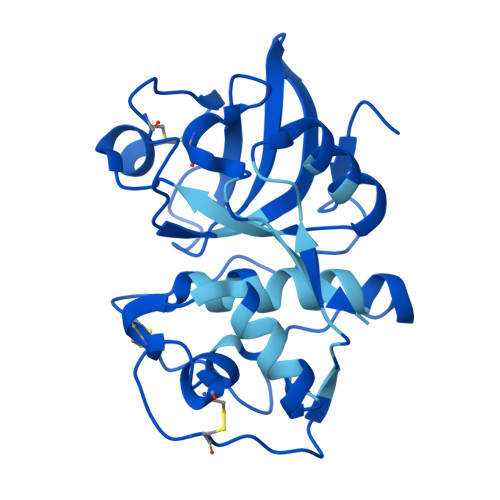Heparan sulfate selectively inhibits the collagenase activity of cathepsin K.
Zhang, X., Luo, Y., Hao, H., Krahn, J.M., Su, G., Dutcher, R., Xu, Y., Liu, J., Pedersen, L.C., Xu, D.(2024) Matrix Biol 129: 15-28
- PubMed: 38548090
- DOI: https://doi.org/10.1016/j.matbio.2024.03.005
- Primary Citation of Related Structures:
8V57, 8V58 - PubMed Abstract:
Cathepsin K (CtsK) is a cysteine protease with potent collagenase activity. CtsK is highly expressed by bone-resorbing osteoclasts and plays an essential role in resorption of bone matrix. Although CtsK is known to bind heparan sulfate (HS), the structural details of the interaction, and how HS regulates the biological functions of CtsK, remains largely unknown. In this report, we discovered that HS is a multifaceted regulator of the structure and function of CtsK. Structurally, HS forms a highly stable complex with CtsK and induces its dimerization. Co-crystal structures of CtsK with bound HS oligosaccharides reveal the location of the HS binding site and suggest how HS may support dimerization. Functionally, HS plays a dual role in regulating the enzymatic activity of CtsK. While it preserves the peptidase activity of CtsK by stabilizing its active conformation, it inhibits the collagenase activity of CtsK in a sulfation level-dependent manner. These opposing effects can be explained by our finding that the HS binding site is remote from the active site, which allows HS to specifically inhibit the collagenase activity without affecting the peptidase activity. At last, we show that structurally defined HS oligosaccharides effectively block osteoclast resorption of bone in vitro without inhibiting osteoclast differentiation, which suggests that HS-based oligosaccharide might be explored as a new class of selective CtsK inhibitor for many diseases involving exaggerated bone resorption.
- Department of Oral Biology, School of Dental Medicine, University at Buffalo, the State University of New York, Buffalo, NY 14214, USA.
Organizational Affiliation:




















